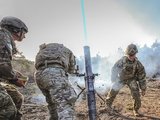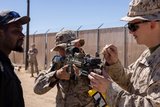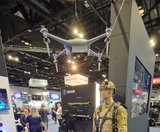Italian Air Force receives Predator Mission Trainer
CAE has delivered a Predator Mission Trainer system to the Italian Air Force, the company announced on 25 February.
The simulator has entered into service at Italian Air Force’s Amendola Air Force Base.
Jointly developed by CAE and General Atomics Aeronautical Systems, the Predator Mission Trainer represents the Italian Air Force’s Predator A UAS during phase one of this delivery. Over the next several months during phase two of delivery, the Predator B/MQ-9 variant of the Predator Mission Trainer will undergo acceptance testing with the Italian Air Force.
The system will allow for zero flight time training if desired. For the physical hardware, CAE used an original Block 1 ground control station provided by the Italian Air Force to ensure the highest level of fidelity and
realism.
The trainer features CAE’s sensor simulation, fully interactive tactical environment for enhanced mission training, and use of the Open Geospatial Consortium Common Database architecture for interoperable and networked training capabilities.
Gene Colabatistto, group president, defense and security, CAE, said: ‘The development of the Predator Mission Trainer for the Italian Air Force represents a new level of fidelity and capability in the use of synthetic training for remotely piloted aircraft pilots and sensor operators.
‘We have leveraged our decades of experience developing the highest fidelity flight simulators for commercial and military aircraft, and applied the same discipline to the Predator Mission Trainer so that aircrews will be able to conduct all training in the simulator without necessarily requiring further training on the actual aircraft. Once the Predator B variant is accepted, this Predator Mission Trainer will be the first Level D equivalent simulator for an unmanned aircraft.’
Related Equipment in Defence Insight
More from Training
-
![Cubic tailors mortar simulator for the US Army]()
Cubic tailors mortar simulator for the US Army
The company’s mortar trainer received improvements based on soldier’s feedback.
-
![Saab expands footprint in the US]()
Saab expands footprint in the US
The company will operate in two new locations in the coming years to better support US services.
-
![How terrain management capabilities can improve military training]()
How terrain management capabilities can improve military training
This type of tool provides more realistic training easing the incorporation of new scenarios that accurately represent the threats of the battlefield.
-
![I/ITSEC 2024: Australian Army approaches second phase of countermining training]()
I/ITSEC 2024: Australian Army approaches second phase of countermining training
The Engineering Corps has been conducting individual instruction using FLAIM Systems’ Sweeper and should start collective deployments in 2025.
-
![I/ITSEC 2024: Zeiss introduces Velvet 4K SIM projector for night flight simulation]()
I/ITSEC 2024: Zeiss introduces Velvet 4K SIM projector for night flight simulation
The next-generation platform is motion-compatible and can be used in OTW and NVG applications.
-
![I/ITSEC 2024: Saab introduces UAV live training capability]()
I/ITSEC 2024: Saab introduces UAV live training capability
The system can be used to prepare soldiers for both drone offensive operations and CUAS missions.



























